Complete Solutions to Single Correct of chapter GEOMETRICAL OPTICS of Class 12 book with complete answers and questions
| Class 12 | PHYSICS |
| Chapter | GEOMETRICAL OPTICS |
| CENGAGE PHYSICS | Single Correct |
| Number Of Questions | 100 |
| Academic Year | 2023-24 |
A beam of light passes from medium 1 to medium 2 to medium 3 as shown figure. What may be concluded about the three indices of refraction, `n_(1),n_(2),and n_(3)` ?
 03:02View Solution
03:02View SolutionA ray of light is incident on a medium with angle of incidence I and refracted into a second medium with angle of refraction r. The graph of `sin(i) vs sin(R)` is as shown in figure. Then the velocity of light in the first medium in n times the velocity of light in the second medium. What shoul be th evalue of n?
 02:57View Solution
02:57View SolutionA beam of light propagates through a medium 1 and falls onto another medium 2, at an angle `alpha_(1)` as shown in figure. After that, it propagates in medium 2 at an angle `alpha_(2)` as shown. The light's wavelength in medium 1 is `lambda_(1)`. What is the wavelength of light in medium
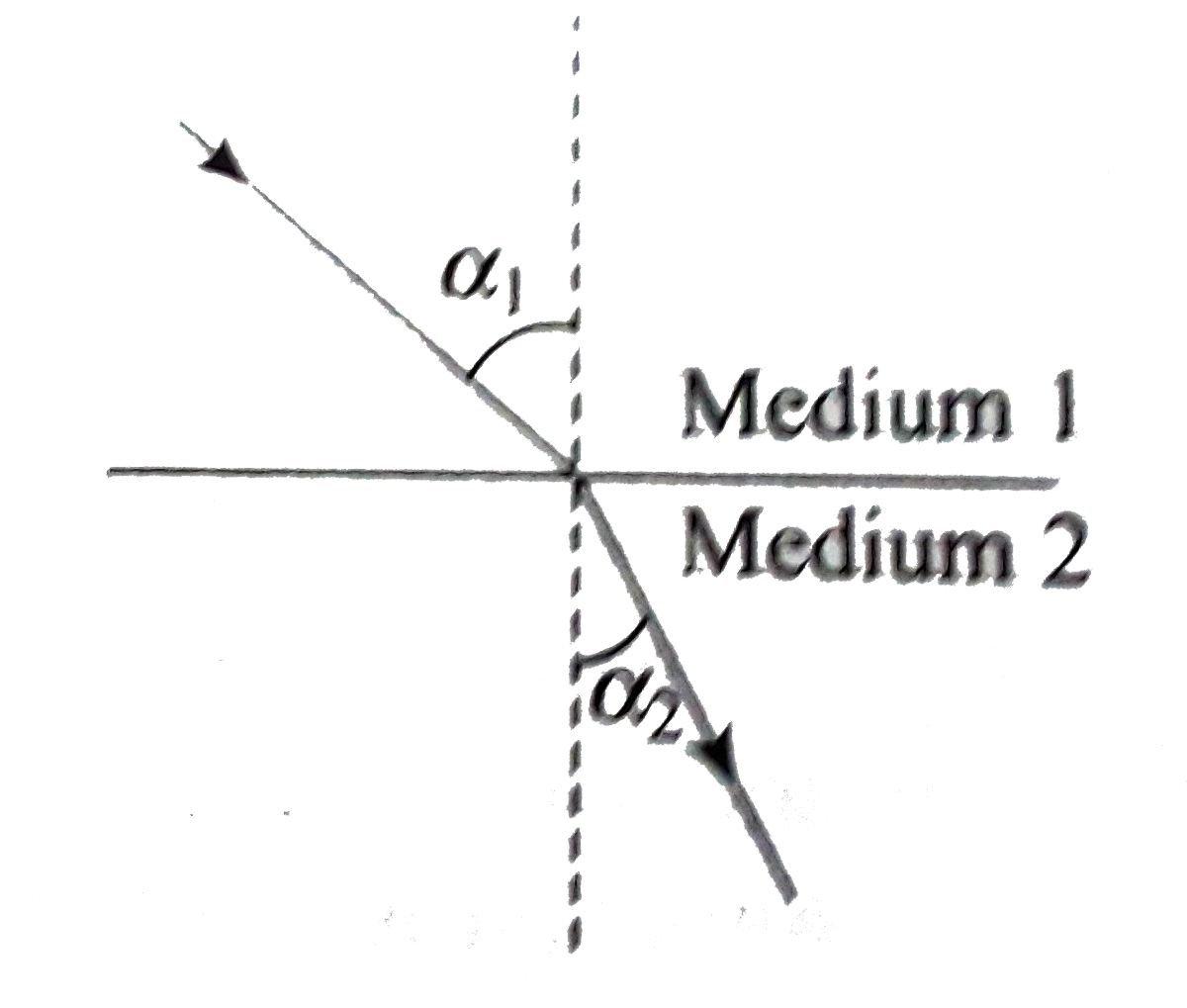 01:45View Solution
01:45View SolutionYou are given two identical plano-convex lenses. When you palce an object 20cm to the left of a single plano-convex lens, the image appears 40cm to the right of the lens. You then arrange the two plano-convex lenses back to back to form a double convex lens. If the object is 20cm to th eleft of this new lens, what is the approximate location of the image?
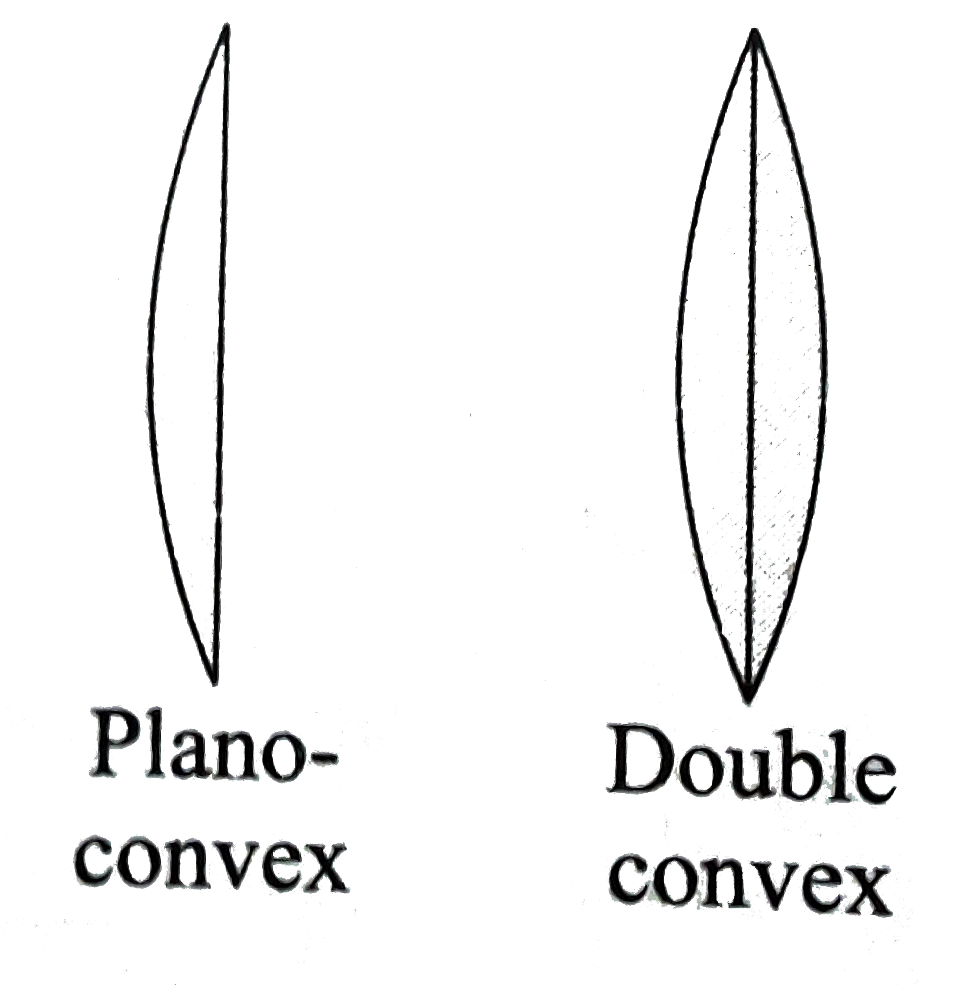 02:13View Solution
02:13View SolutionLight from a denser medium 1 passes to a rarer medium 2. When the angle of incidence is `theta` the partially reflected and refracted rays are mutually perpendicular. The critical angle will be
 03:08View Solution
03:08View SolutionLight is incident on a glass block as shown in figure. If `theta_(1)` is increased slightly, what happens to `theta_(2)`
 01:57View Solution
01:57View SolutionA thin equiconvex lens `(mu=3//2)` of focal length 10cm is cut and separated and a material of refractive index 3 is filled between them. What is the focal length of the combination?
 04:21View Solution
04:21View SolutionBehind a thin converging lens having both the surfaces of the same radius 10cm, a plane mirror has been placed. The image of an object at a distance of 40 cm from the lens is formed at the same position. What is the refractive index of the lens?
 02:01View Solution
02:01View SolutionWhat should be the value of distance d so that final image is formed on the object itself. (Focal length of the lenses are written on the lenses.)
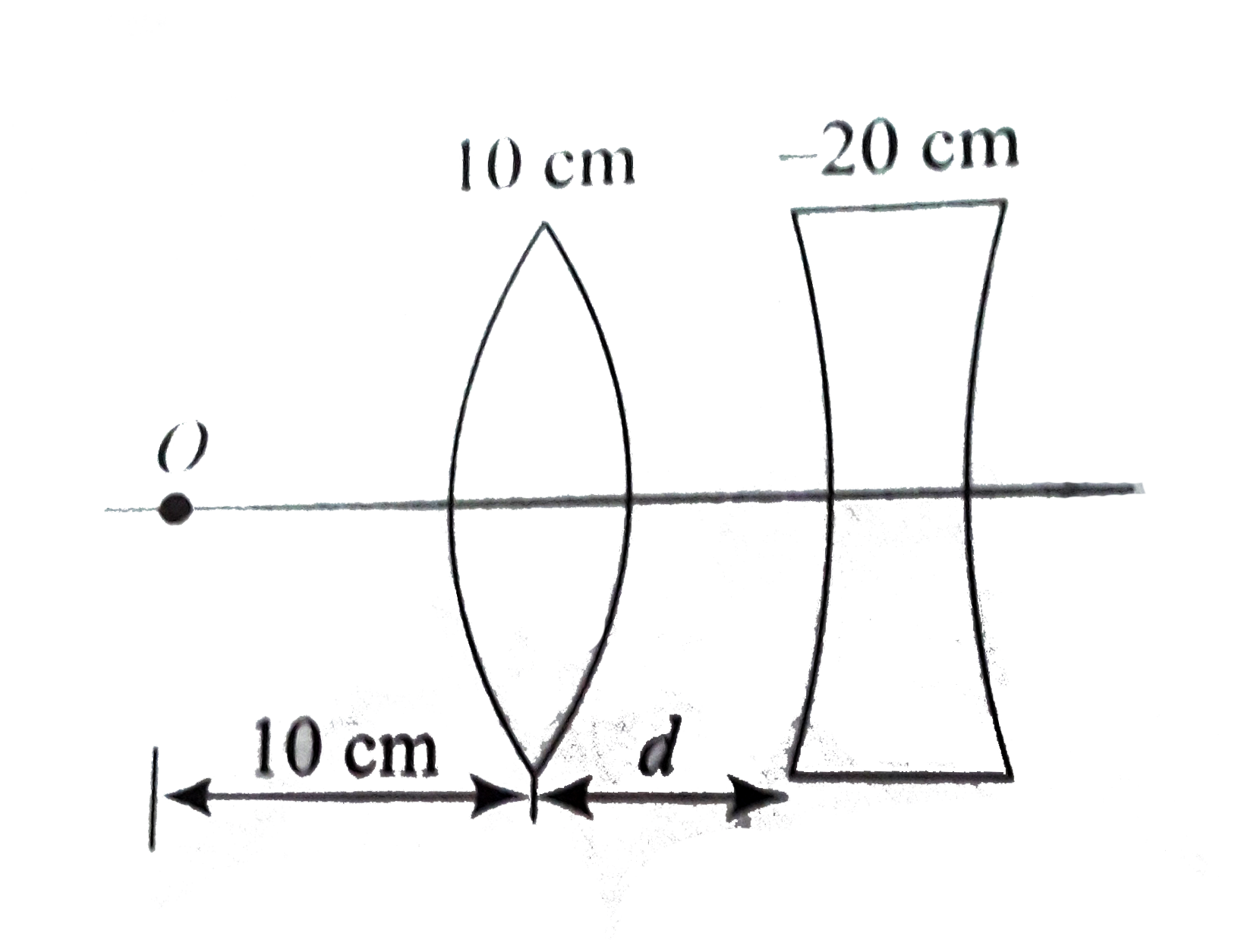 03:40View Solution
03:40View SolutionA ray of light passes from glass, having a refractive indx of 1.6, to air. The angle of incidence for which the angle of refraction is twice the angle of incidence is
02:54View SolutionConsider an equiconvex lens of radius of curvature R and focal length f. If `fgtR` , the refractive index `mu` of the material of the lens
02:13View SolutionA fish is vertically below a flying bird moving vertically down toward water surface. The bird will appear to the fish to be
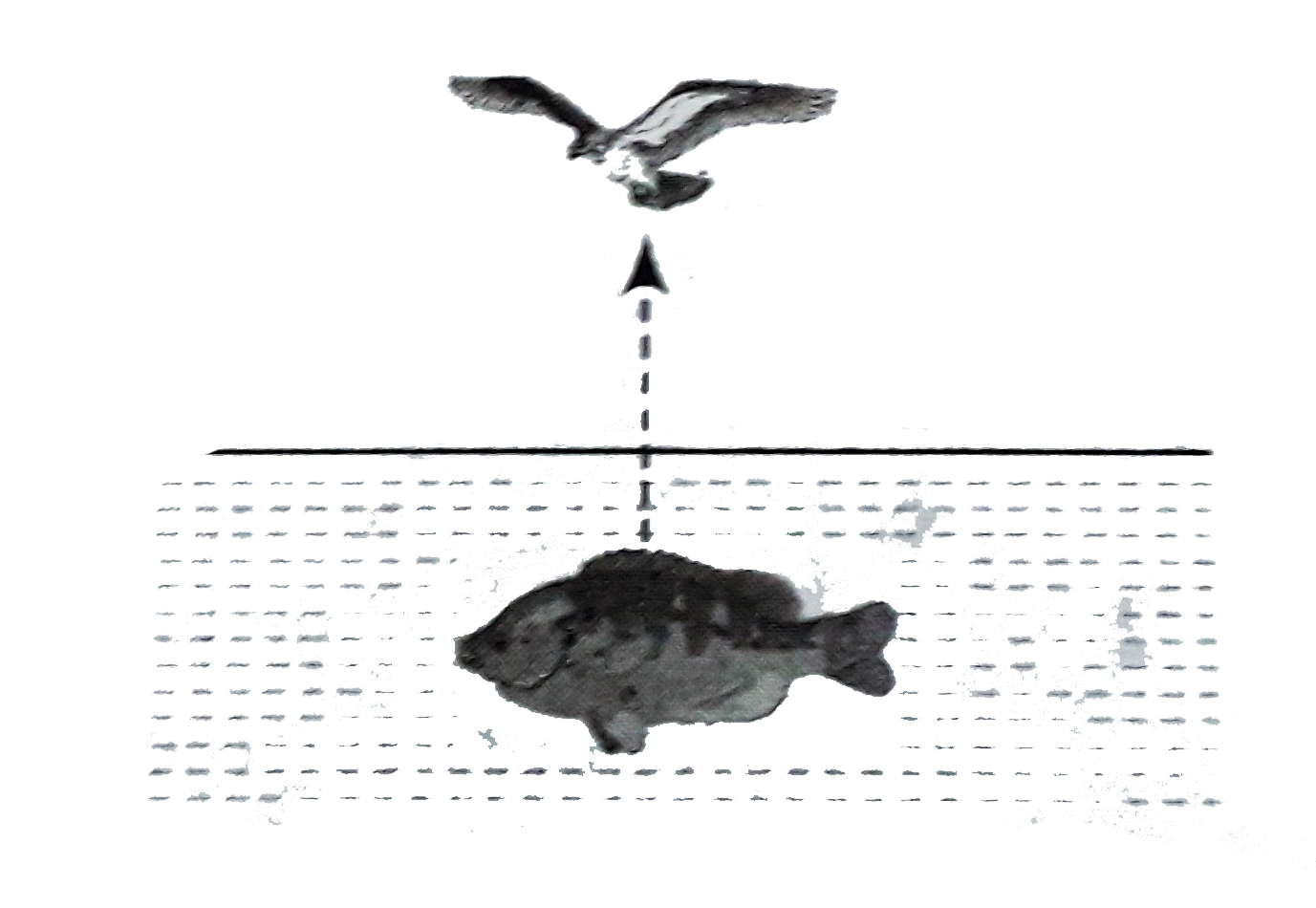 03:20View Solution
03:20View SolutionWhat is the angle of incidence for an equilateral prism of refractive index `sqrt(3)` so that the ray si parallel to the base inside the prism?
03:49View SolutionA cube of side 2m is placed in front of a concave mirror of focal l ength 1m with its face A at a distance of 3m and face B at a distance of 5m form the mirror. The distance between the images of faces A and B and heights of images of A and B are , repectively,
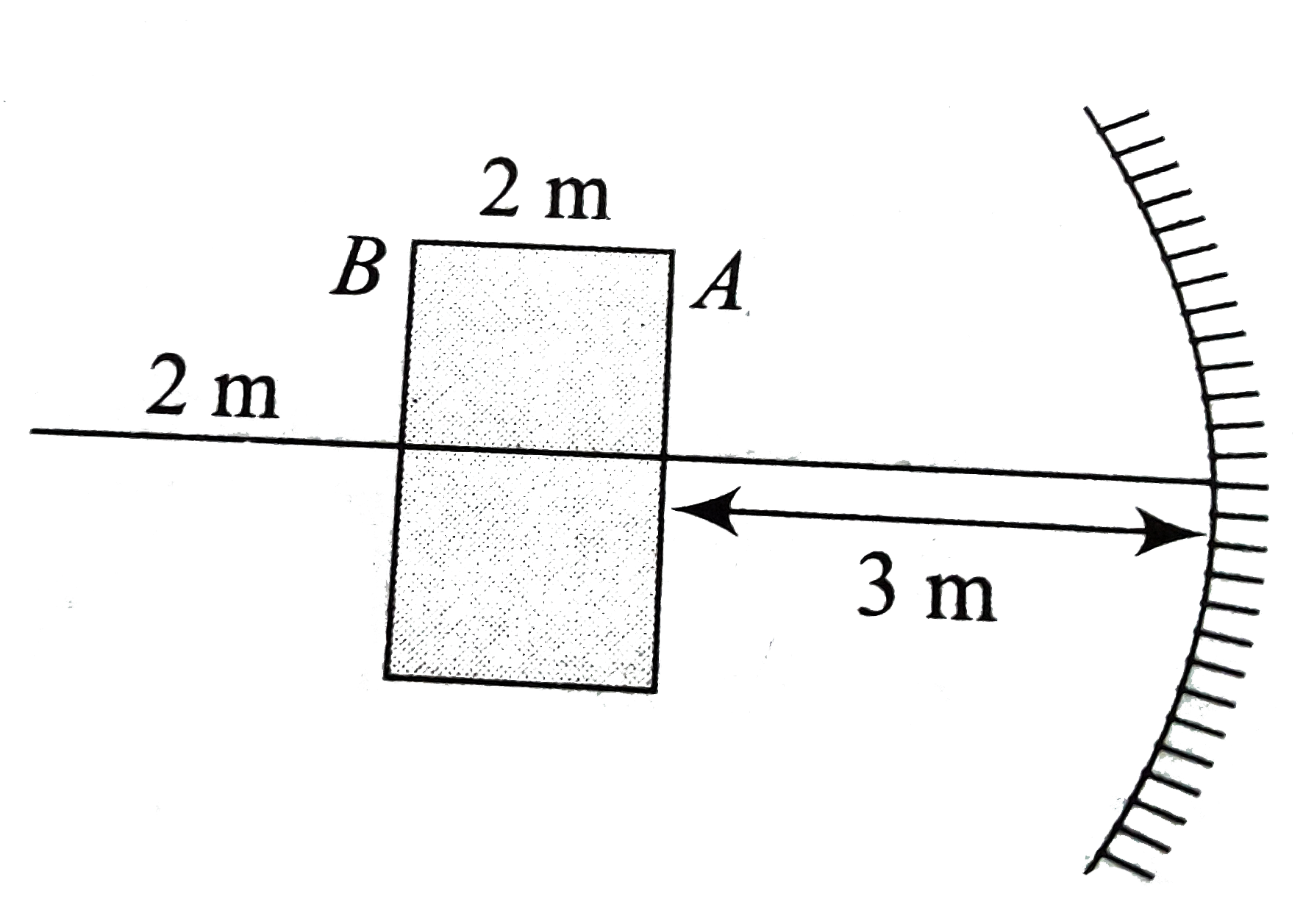 01:38View Solution
01:38View SolutionA plano-convex lens when silvered ono the plane side behaves like a concave mirror of focal length 60 cm. However, when silvered on the convex side, it behaves like a concave mirror of focal length 20cm. Then, the refractive index of the lens is
View SolutionTwo thin lenses are placed 5cm apart along the same axis and illuminted with a beam of light parallel to that axis. The first lens in the path of the beam is a converging lens of focal length 10cm whereas the second is a diverging lens of focal length 5cm. If the second lens if now moved toward the first, the emergent light
01:23View SolutionA lens forms a real image of an object. The distance from the object to the lens is x cm and that from the lens to the image is y cm. The graph shows the variation of y with x.
It can be deduced that the lens is
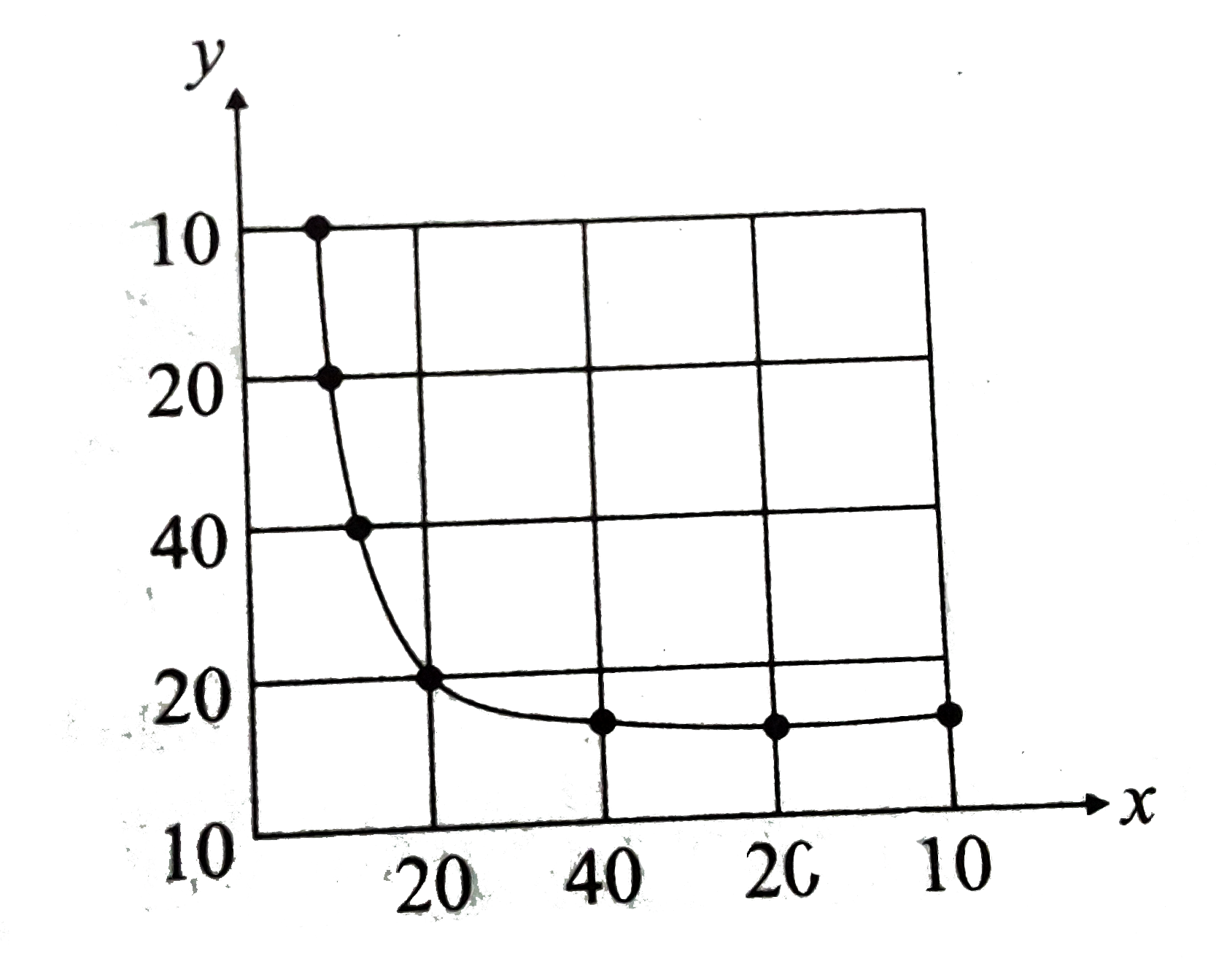 02:40View Solution
02:40View SolutionA plastic hemisphere has a radius of curvature of 8cm and an index of refraction of 1.6. On the axis halfway between the plane surface and the spherical one (4cm from each) is a small object O.
The distance between the two images when viewed along the axis from the two sides of the hemisphere is approximately.
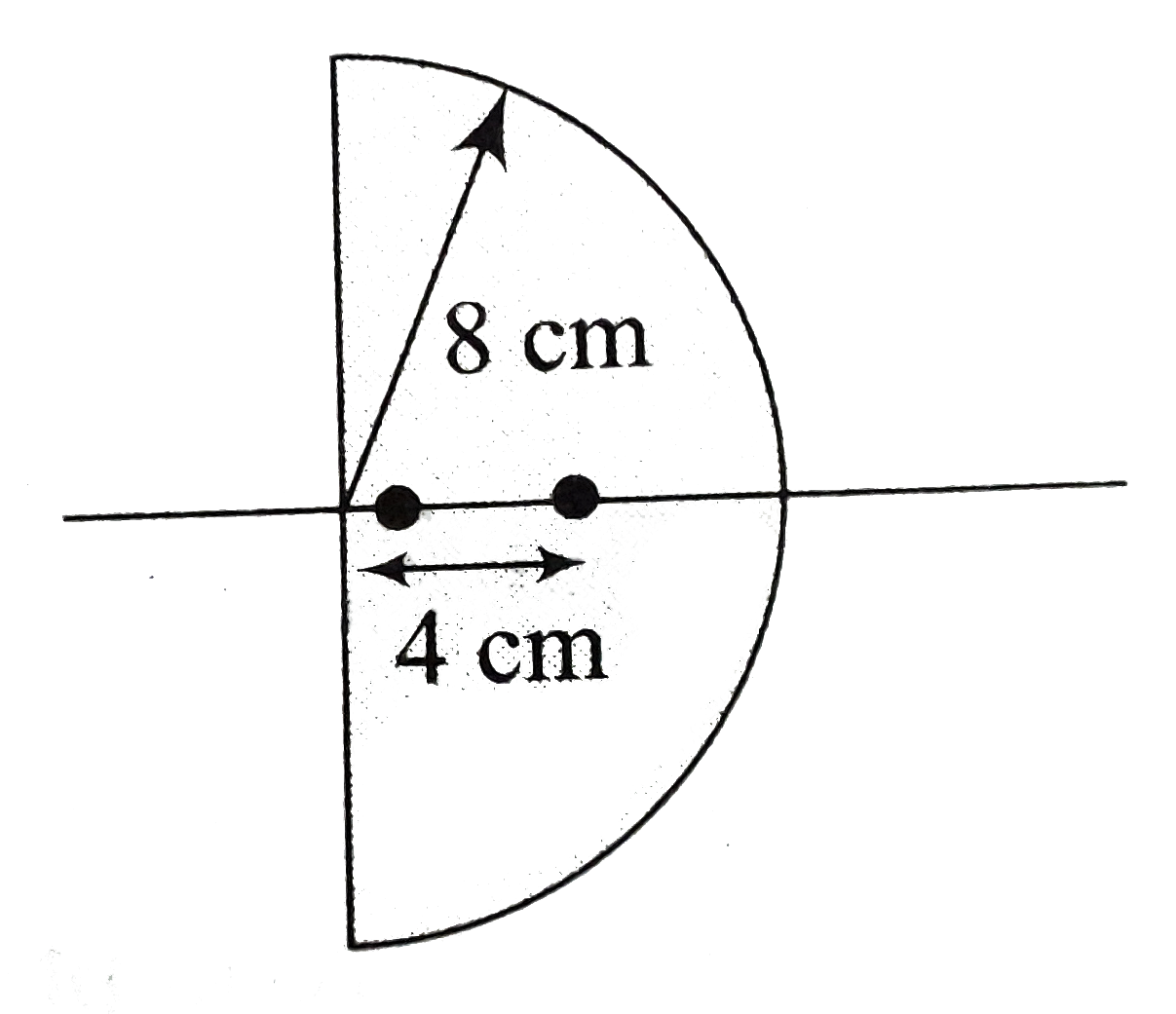 01:40View Solution
01:40View SolutionA ray of light falls on a transparent sphere with center at C as shown in Figure . The ray emerges fromk the sphere paralllel to line AB. Find the refractive index of the sphere.
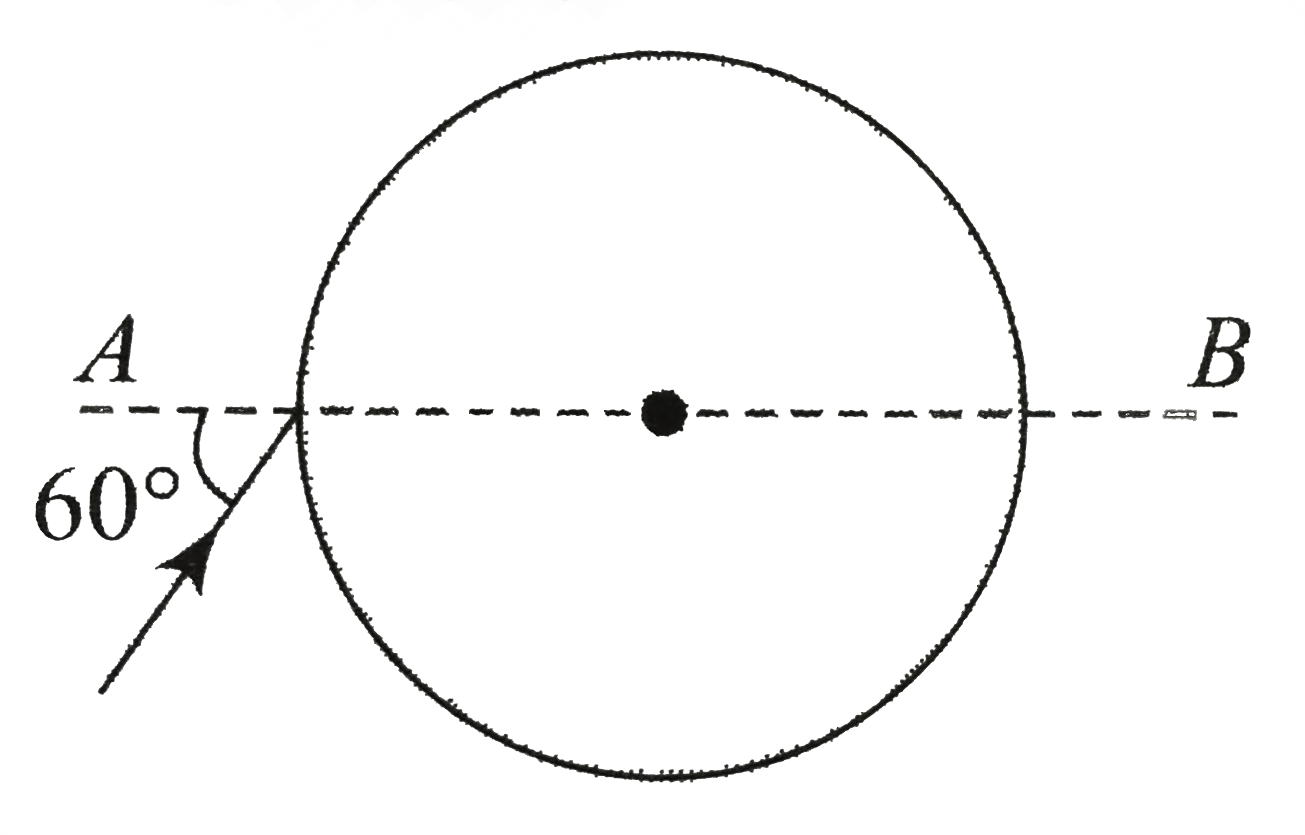 01:09View Solution
01:09View SolutionA circular beam of light of diameter `d = 2 cm` falls on a plane refractive of glass. The angle of incidence is `60^(@)` and refractive index of glass is `mu = 3//2`. The diameter of the refracted beam is
05:48View SolutionCritical angle of glass is `theta_(1)` and that of water is `theta_(2)`. The critical angle for water and glass surface would be `(mu_(g)=3//2, mu_(w)=4//3)`
02:59View SolutionLight is incident normally on face AB of a prism as shown in Figure. A liquid of refractive index `mu` is placed on face AC of the prism. The prism is made of glass of refractive indes `3//2` . Find the limits of `mu` for which total internal reflection takes place on the face AC.
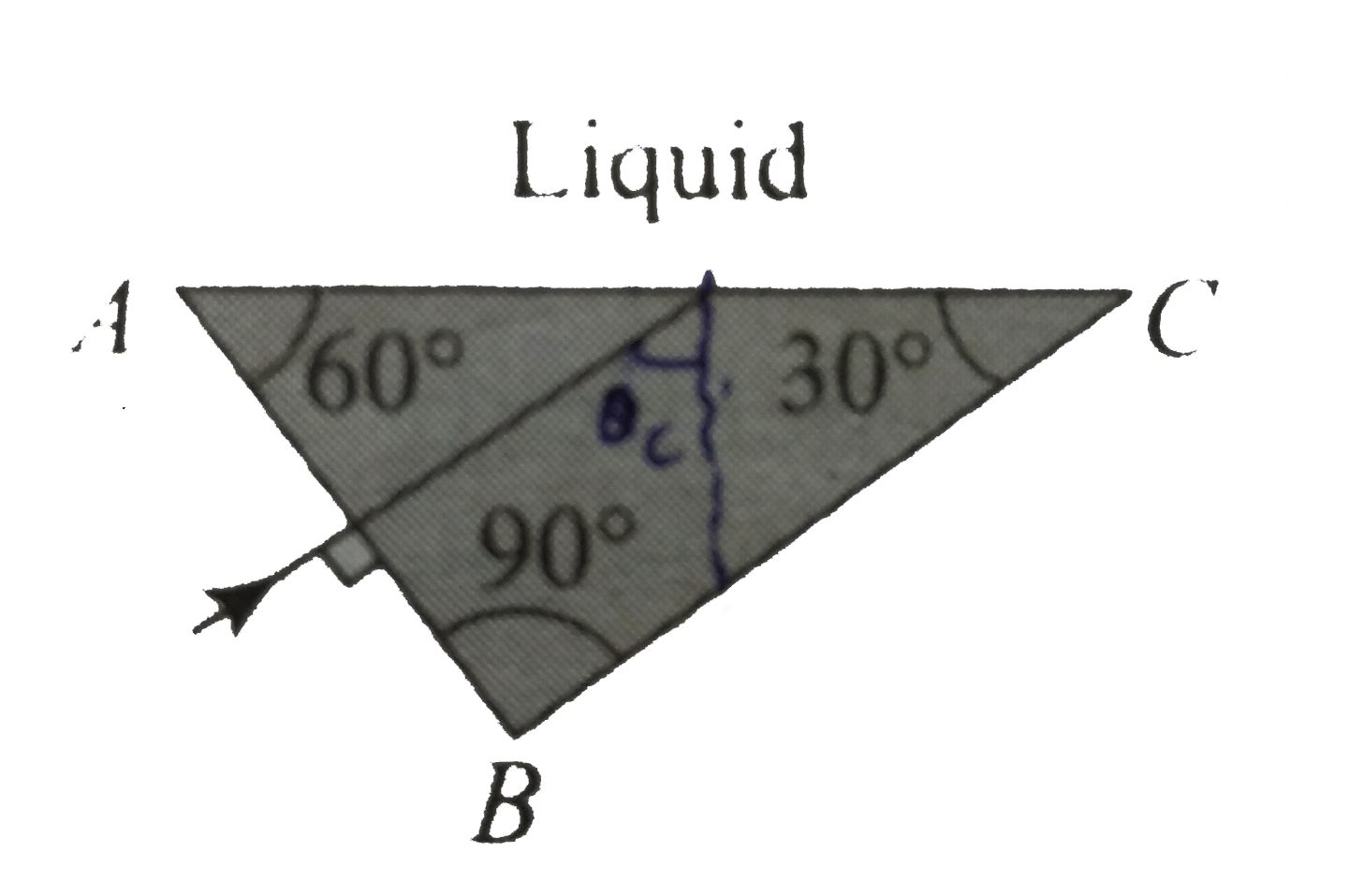 04:26View Solution
04:26View SolutionA ray of light is incident on a glass sphere of refractive index `3//2` . What should be the angle of incidence so that the ray which enters the sphere does not comme out of the sphere?
02:29View SolutionTwo identical glass `(mu_(g)=3//2)` equiconvex lenses of focal length `f` are kept ini contact. The space between the two lenses is filled with water `(mu_(w)=4//3)`. The focal length of the combination is
06:36View SolutionAn object is kept at a distance of 16 cm from a thin lens and the image formed is real. If the object is kept at a distance of 6 cm from the same lens, the image formed is virtual. If the size of the image formed are equal, the focal length of the lens will be
03:52View SolutionPoint object O is placed on the principal axis of a convex lens of focal length 20cm at a distance of 40 cm to the left of it. The diameter of the lens is 10cm to the right of the lens at a distance h below the principal axis, then the maximum value of h to see the image will be
01:37View SolutionLight of wavelength 500nm traveling with a speed of `2.0xx10^(8)ms^(-1)` in a certain medium enters another medium of refractive index `5//4` times that of the first medium. What are the wavelength and speed in the second medium?
03:34View SolutionA hollow double concave lens is made of very thin transparent material. It can be filled with air or either of two liquids `L_(1)` or `L_(2)` having refractive indices `n_(1)` and `n_(2)`, respectively `(n_(2) gt n_(1) gt 1)`. The lens will diverge parallel beam of light if it is filles with
02:33View SolutionThe velocity of light in a medium is half its velocity in air. If a ray of light emerges from such a medium into air, the angle of incidenc, at which it will be totally internally reflected, is
01:40View SolutionA convex lens of focal length 20cm and a concave lens of focal length f are mounted coaxially 5cm apart. Parallel beam of light incident on the convex lens emerges from the concave lens as a parallel beam. Then, f in cm is
02:34View SolutionAn equiconvex lens is made from glass of refractive index 1.5. If the radius of each surface is changed from 5cm to 6cm, then the power
04:08View SolutionAn object is put at a distance of 5cm from the first focus of a convex lens of focal length 10cm. If a real image is formed, its distance from the lens will be
01:14View SolutionA luminous object is placed 20 cm from surface of a convex mirror and a plane mirror is set so that virtual images formed in two mirrors coincide. If plane mirror is at a distance of 12cm from object. Then focal length of convex
03:00View SolutionConsider the situation shown in figure. Water `(mu=4//3)` is filled in a beaker up to a height of 10cm.
A plane mirror is fixed at a height of 5 cm from the surface of water. Distance of image from the mirror after reflection from it of an object O at the bottom of the beaker is
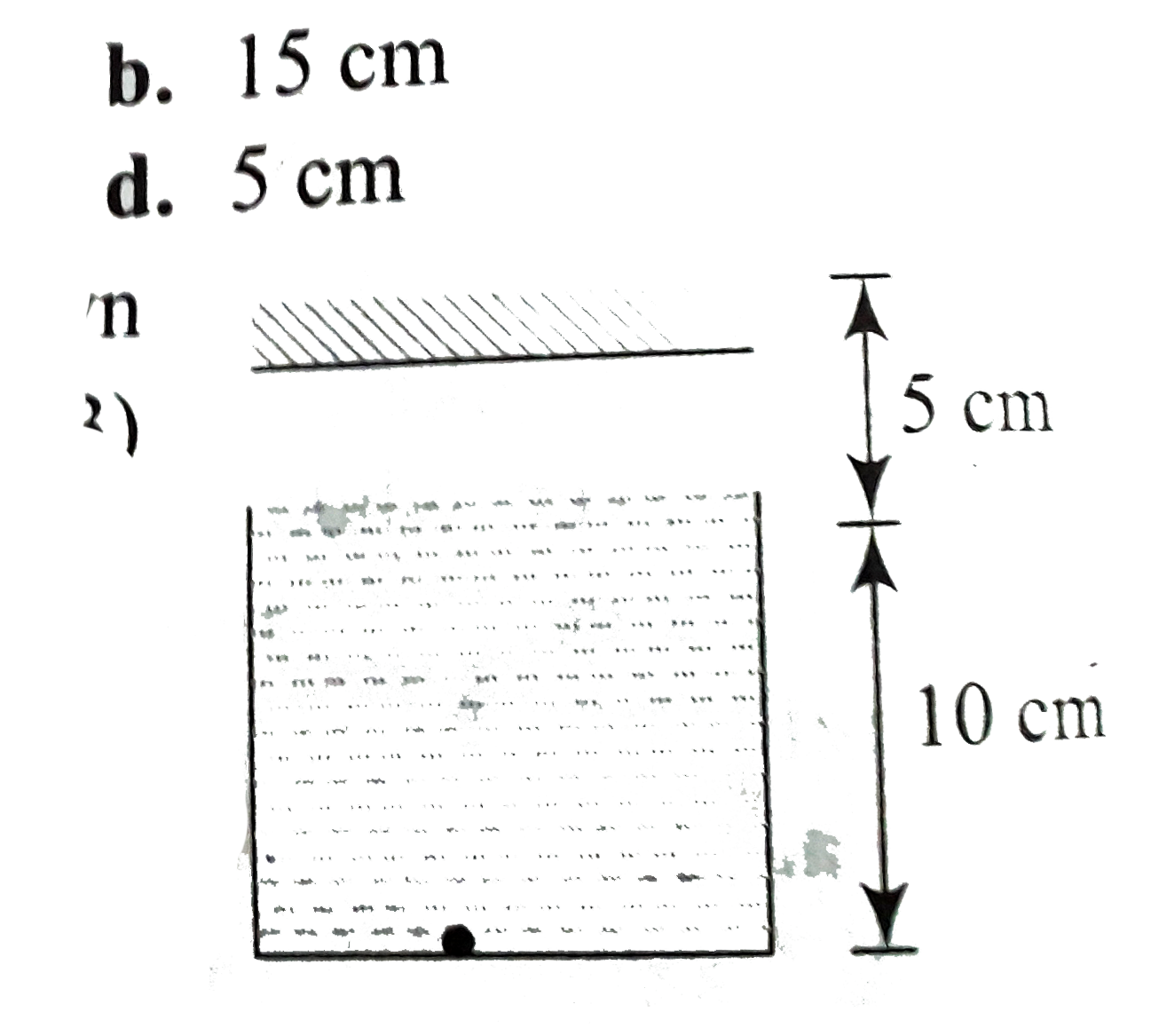 02:23View Solution
02:23View SolutionRefraction takes place at a convex spherical boundary separating glass-air medium. For the image to be real, the object distance `(mu_(g)=3//2)` should be `//`is
02:45View SolutionThe image of point P when viewd from top of the slabs will be
 02:00View Solution
02:00View SolutionThe refractive index of a prism is 2. The prism can have a maximum refracting angle of
01:19View SolutionOne of the refracting surfaces of a prism of angle `30^(@)` is silvered. A ray of light incident at angle of `60^(@)` retraces its path. The refractive index of the material of prism is
02:21View SolutionAngle of minimum deviation is equal to the angle of prism A of an equilateral glass prism. The angle of incidence at which minimum deviation will be obtained is
01:23View SolutionA plano-convex lens fits exactly into a plano-concave lens. Their plane surfaces are parallel to each other. If the lenses are made of different material of refractive indices `mu_(1)` and `mu_(2)` and R is the radius of curvature of the curved surface of the lenses, then focal length of the combination is
02:57View SolutionA parallel beam of light is incident on the system of two convex lenses of focal length `f_(1)=20cm` and `f_(2)=10cm` . What should be the distance between the two lenses so that rays after refraction from both the lenses pass undeviated?
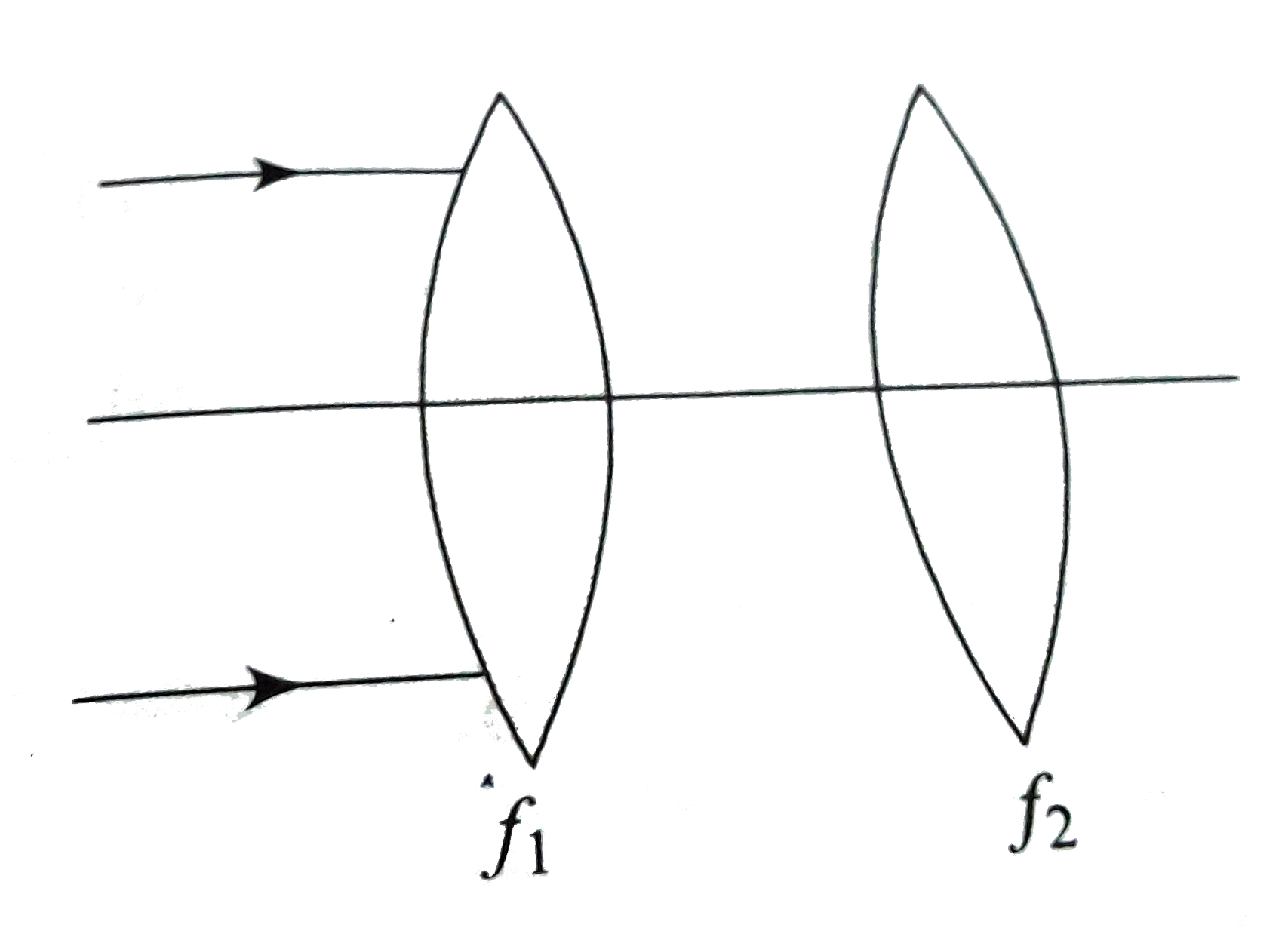 03:32View Solution
03:32View SolutionA point object is placed at a distance of 25 cm from a convex lens of focal length 20cm. If a glass slab of thickness t and refractive index 1.5 is inserted between the lens and the object, the image is formed at infinity. The thickness t is
02:29View SolutionA convex lens of focal length 10cm is painted black at the middle portion as shown in figure . An object is placed at a distance 20cm from the lens. Then,
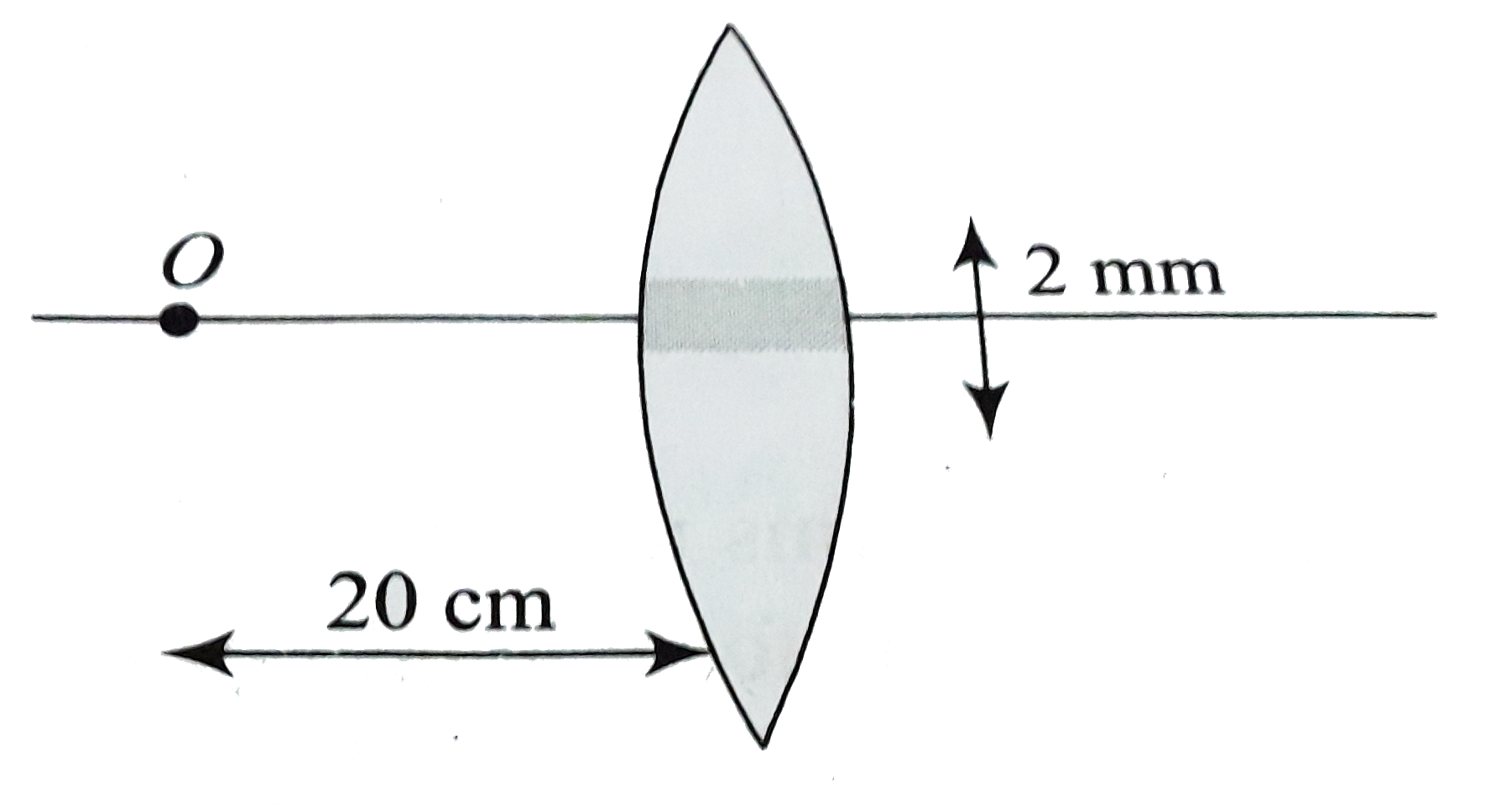 02:23View Solution
02:23View SolutionA cubic container is filled with a liquid whose refractive index increases linearly from top to bottom. Which of the following represents the path of a ray of light inside the liquid?
02:04View SolutionA lens forms a virtual, diminished image of an object placed at 2m from it. The size of image is half of the object. Which one of the following statements is correct regarding the nature and focal length of the lens?
01:05View SolutionTwo convex lenses placed in contact form the image of a distant object at P. If the lens B is moved to the right, the image will
 01:31View Solution
01:31View SolutionAn equiconvex lens is cut into two halves along `(i) XOX^(')` and `(ii) YOY^(')` as shown in the figure. Let `f,f^(')f^('')` be the focal lengths of the complete lens, of each half in case `(i)`, and of each half in case `(ii)`, respectively
Choose the correct statement from the following
 04:25View Solution
04:25View SolutionA spherical mirror forms an image of magnification3. The object distance, if focal length of mirror is 24cm, may be
01:50View SolutionThe critical angle for light going from medium X into medium Y is `theta` . The speed of light in medium X is v. The speed of light in medium Y is
04:35View SolutionAn object 15cm high is placed 10cm from the optical center of a thin lens. Its image is formed 25cm from the optical center on the same side of the lens as the object
01:03View Solutiona convex lens of power `+6` dioptre is placed in contact with a concave lens of power`-4` dioptre. What will be the nature and focal length of this combination?
01:46View SolutionA convex lens of focal length 1.0m and a concave lens of focal length9.25m are 0.75m apart. A parallel beam of light is incident on the convex lens. The beam emerging after refraction from both lenses is
01:36View SolutionA convex lens A of focal length 20cm and a concave lens G of focal length 5cm are kept along the same axis with the distance d between them. If a parallel beam of light falling on A leaves B as a parallel beam, then distance d in cm will be
01:54View SolutionA convex lens forms an image of an object placed 20cm away from it at a distance of 20cm on the other side of the lens. If the object is moves 5cm toward the lens, the image will be
02:55View SolutionWith a concave mirrorr, an object is placed at a distance `x_(1)` from the principal focus, on the principal axis. The image is formed at a distance `x_(2)` from the principal focus. The focal length of the mirrorr is
03:49View SolutionA concave mirror is placed on a horizontal table, with its axis directed vertically upwards. Let O be the pole of the mirror and C its centre of curvature. A point object is placed at C. It has a real image, also located at C. If the mirror is now filled with water, the image will be.
02:34View SolutionA plane mirror is made of glass slab (`mu_(g)=1.5`) 2.5 cm thick and silvered on back. A point object is placed 5 cm in front of the unsilvered face of the mirror. What will be the position of final image ?
03:49View SolutionA point source of light B is placed at a distance L in front of the center of a mirror of width d hung vertically on a wall. A man walks in front of mirror along a line parallel to the mirror at a distance 2L from it as shown in Figure. The greatest distance over which he can see the image of the light source in the mirror is
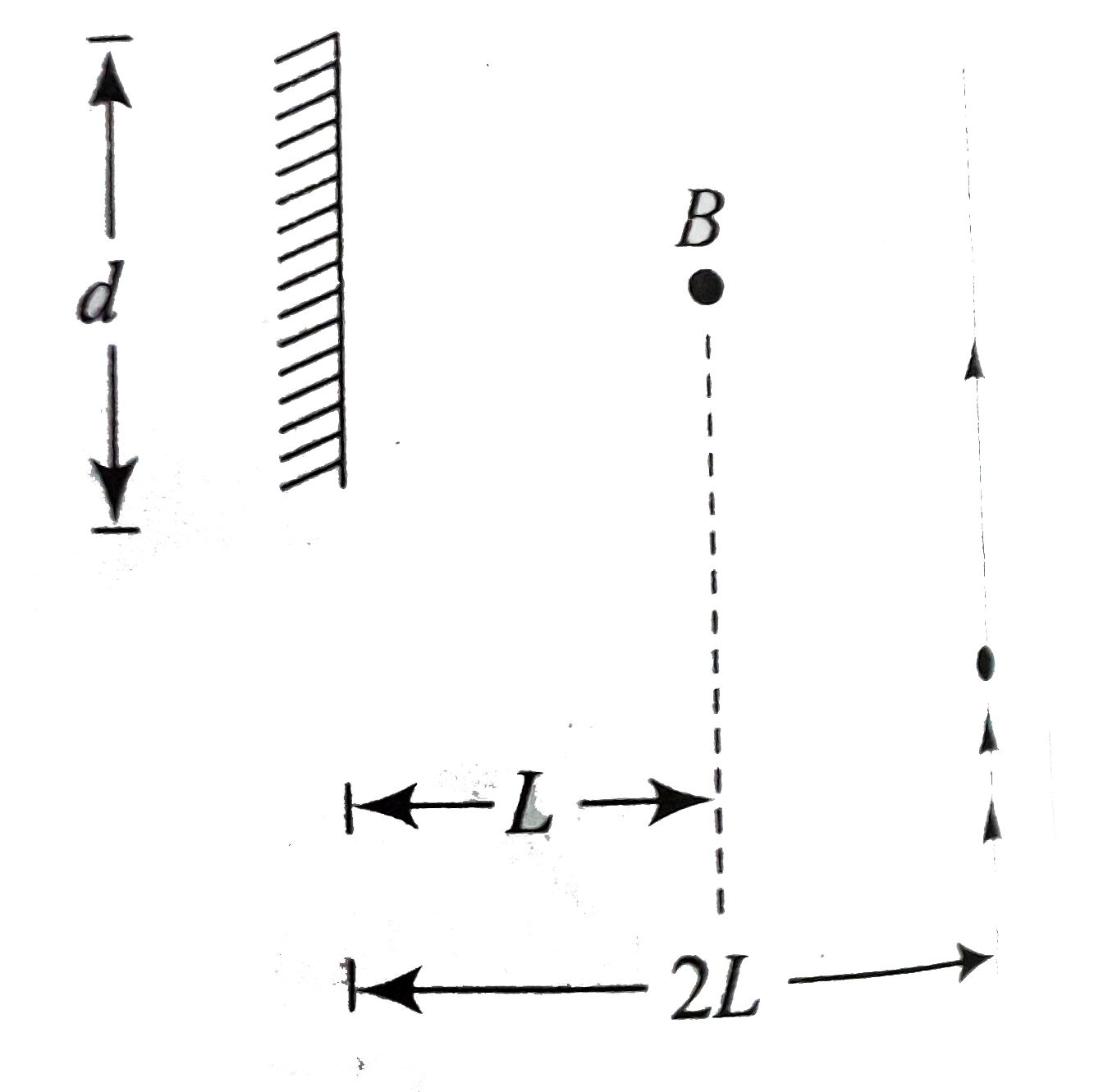 03:33View Solution
03:33View SolutionAn object is object at a distance of 25cm from the pole of a convex mirror and a plane mirror is set at a distance 5 cm from convex mirror so that the virtual images formed by the two mirrors do not have any parallax. The focal length of the convex mirror is
03:27View SolutionWhen an object is kept at a distance of 30cm from a concave mirror, the image is formed at a distance of 10 cm. If the object is moved with a speed of `9cm s^(-1)` the speed with which the image moves is
02:08View SolutionA convex mirror of radius of curvature 1.6m has an object placed at a distance of 1m from it. The image is formed at a distance of
01:37View SolutionIn the above question, the magnification is
00:30View SolutionA convex mirror and a concave mirror of radius 10cm each are placed 15cm apart facing each other. An object is placed midway between them. If the reflection first takes place in the concave mirror and then in convex mirror, the position of the final image is
03:01View SolutionA small piece of wire bent into an L shape, with upright and horizontal portions of equal lengths, is placed with the horizontal portion along the axis of the concave mirror whose radius of curvature is 10cm. I fthe bend is 20cm from the pole of the mirror, then the ration of the lengths of the images of the upright and horizontal portions of the wire is
05:33View SolutionThe image of an object placed on the principal axis of a concave mirror of focal length 12 cm is formed at a point which is 10cm more distance form the mirror than the object. The magnification of the image is
02:25View SolutionA clear transparent glass sphere `(mu=1.5)` of radius R is immersed in a liquid of refractive index 1.25. A parallel beam of light incident on it will converge to a point. The distance of this point from the center will be
06:59View SolutionA ray of light from a denser medium strikes a rarer medium at an angle of incidenc i. The reflected and refracted rays make an angle of `pi//2` with each other. If the angles of reflection and refraction are r and `r^(')` , then the criticall angle will be
04:01View SolutionA ray of light traveling in glass `(mu=3//2)` is incident on a horizontal glass-air surface at the critical angle `theta_(C)`. If a thin layer of water `(mu=4//3)` is now poured on the glass-air surfac, the angle at which the ray emerges into air at the water-air surface is
01:44View SolutionA ray of light enters a rectangular glass slab of refractive index `sqrt(3)` at an angle of incidence `60^(@)`. It travels a distance of 5cm inside the slab and emerges out of the slab. The perpendicular distance between the incident and the emergent rays is
06:05View SolutionA ray of monochromatic light is incident on the refracting face of a prism (angle `75^(@)0` . It passes through the prism and is incident on the other face at the critical angle. If the refractive index of the prism is `sqrt(2)` , then the angle of incidence on the first of the prism is
01:48View SolutionAn object is placed at a distance of 15cm from a convex lenx of focal length 10cm. On the other side of the lens, a convex mirror is placed at its focus such that the image formed by the combination coincides with the object itself. The focal length of the convex mirror is
04:45View SolutionACB is right-angled prism with other angles as `60^(@)` and `30^(@)` . Refractive index of the prism is 1.5. AB has thin layer of liquid on it as shown. Light falls normally on the face Ac. For total internal reflection, maximum refractive index of the liquid is
 01:30View Solution
01:30View SolutionThe lateral magnification of the lens with an object located at two different position `u_(1)` and `u_(2)` are `m_(1)` and `m_(2)` , respectively. Then the focal length of the lens is
01:42View SolutionA parallel beam of light falls axially on a thin converging lens of focal length 20cm. The emergent light falls on a screen placed 30cm beyond the lens. An opaque plate with a triangular aperture, side 1 cm, is in contact with the lens
Which one of the following diagrams best shows to appearance of the patch of light seen on the screen?
 01:22View Solution
01:22View SolutionA liquid of refractive index 1.6 is contained in the cavity of a glass specimen of refractive index 1.5 as shown in figure. If each of the curve surface has a radius of curvature of 0.20m, the arrangement obehaves as a
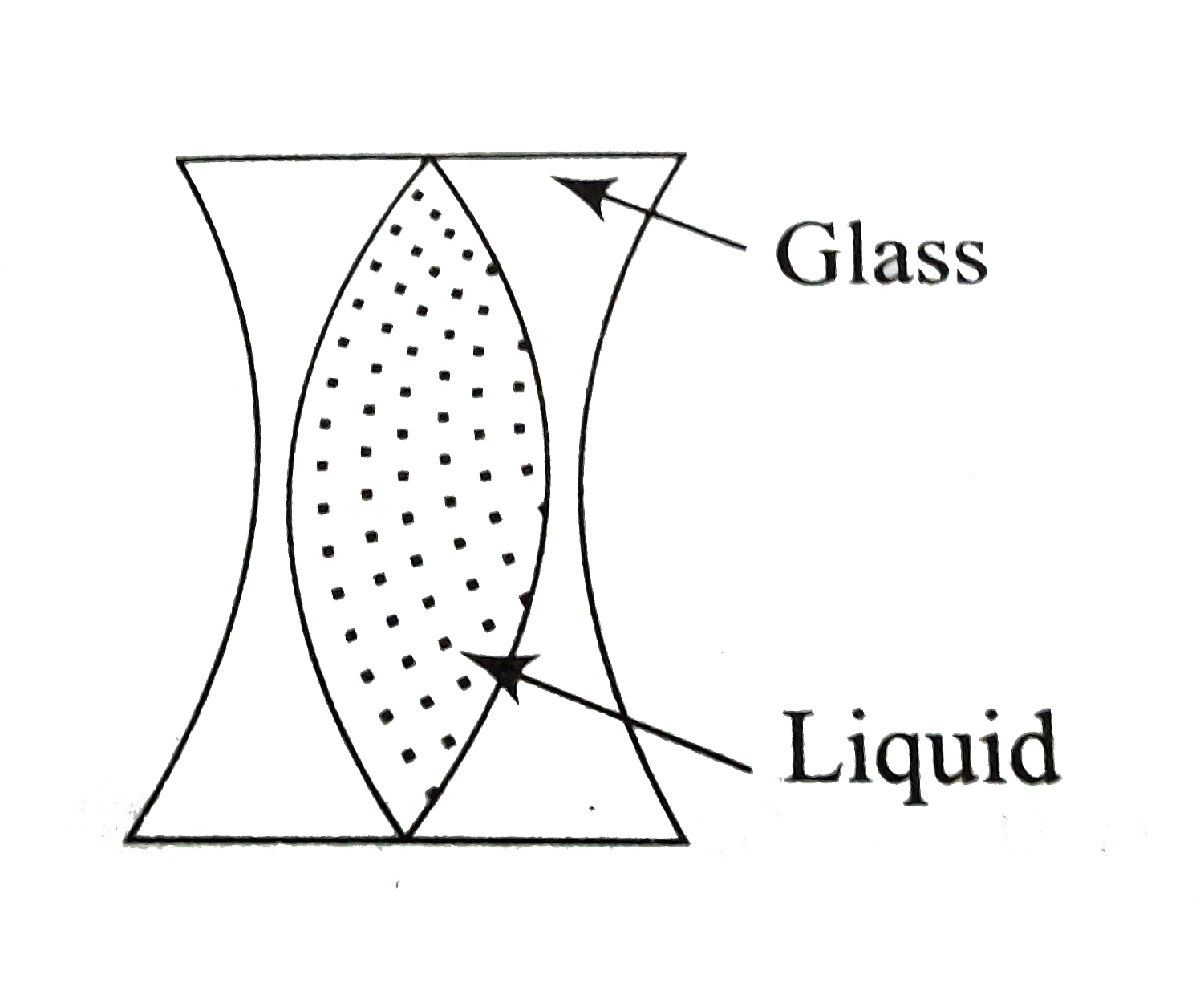 03:25View Solution
03:25View SolutionFigure(a) shows two plano-convex lenses in contact as shown. The combination has focal length 24cm. Figure (b) shows the same with a liquid introduced between them. If refractive index of glass of the lenses is 1.50 and that of the liquid is 1.60, the focal length of system in figure (b) will be
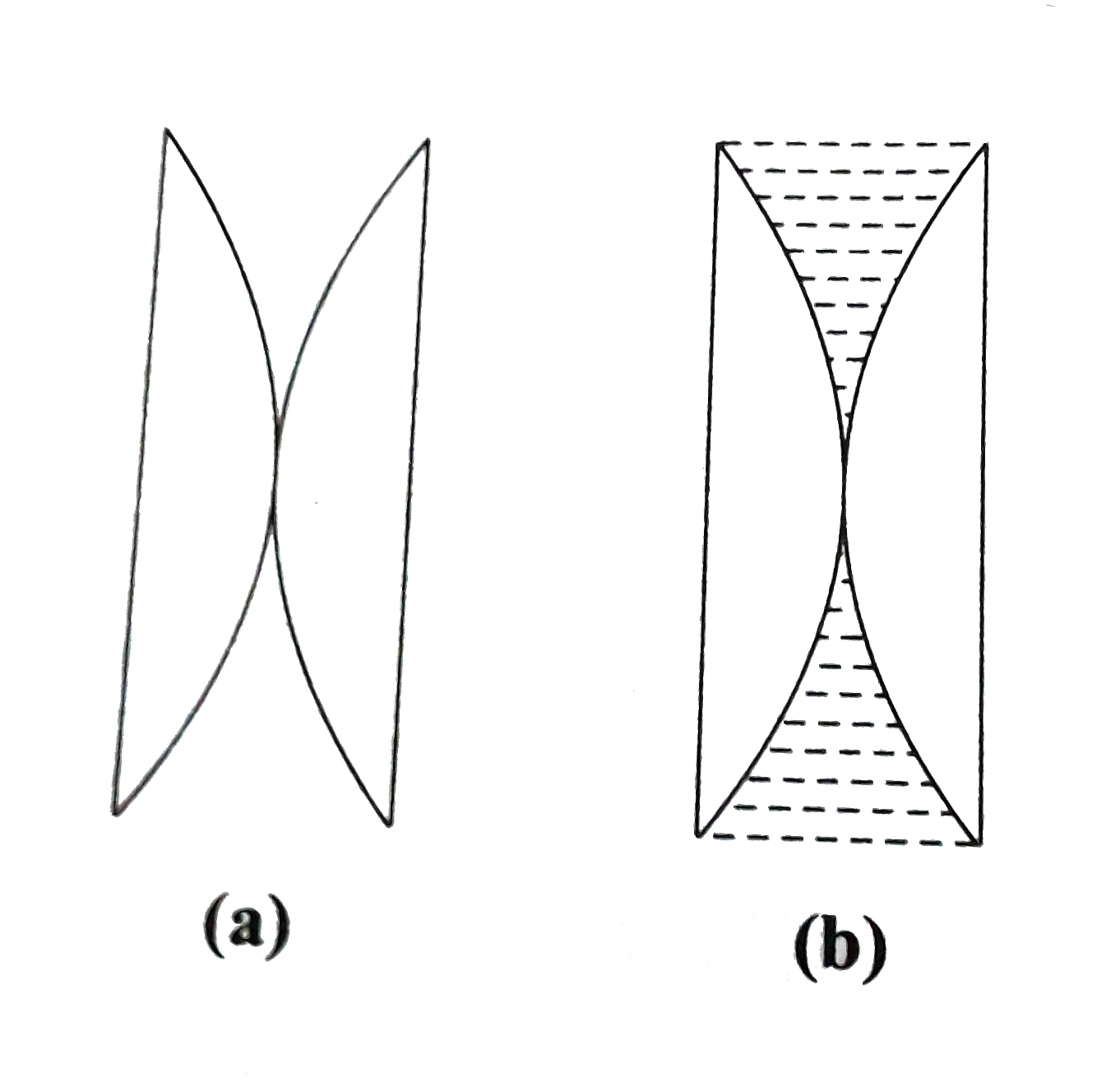 02:31View Solution
02:31View SolutionIn a slide show programme, the image on the screen has an area 900times that of the slide. If the distance between the slide and the screen is x times the distance between the slide and the projector lens, then
01:14View SolutionA glass prism has refractive index `sqrt(2)` and refracting angle `30^(@)` . One of the refracting surface of the prism is silvered. A beam of monochromatic light will retrace it path it its angle of incidence on the unsilvered refracting surface of the prism is
02:31View SolutionA fish rising up vertically toward the surface of water with speed `3ms^(-1)` observes a bird diving down vertically towards it with speed `9ms^(-1)` . The actual velocity of bird is
 02:28View Solution
02:28View SolutionA concave lens with unequal radii of curvature made of glass `(mu_(g)=1.5)` has a focal length of 40cm. If it is immersed in a liquid of refractive index `mu_(1)=2`, then
02:04View SolutionThe refractive index of material of a prism of angles `45^(@)`, `-45^(@)`, and `-90^(@)` is 1.5. The path of the ray of light incident normally on the gypotenuse side shown in
01:45View SolutionAn object is placed 1m in front of the curved surface of a plano-convex lens whose plane surface is silvered. A real image is formed in front of the lens at a distance of 120cm. Then, the focal length of the lens is
01:42View SolutionThe apparent thickness of a thick plano-convex lens is measured once with the plane face upward and then with the convex face upward. The value will be
02:21View SolutionAn object is placed in front of a convex mirror at a distance of 50cm. A plane mirror is introduced covering the lower half of the convex mirror. If the distance between the object and the plane mirror is 30cm, it is found that there is no parallax between the images formed by the two mirrors. What is the radius of curvature of the convex mirror?
01:41View SolutionA concave mirror of focal length 10cm and a convex mirror of focal length 15cm are placed facing each other 40cm apart. A point object is placed between the mirrors, on their common axis and 15cm from the concave mirror. Find the position and nature of the image produced by successive reflections, first at the concave mirror and then at the convex mirror.
02:51View SolutionA U-shaped wire is placed before a concave mirror having radius of curvature 20cm as shown in figure,. Find the total length of the image.
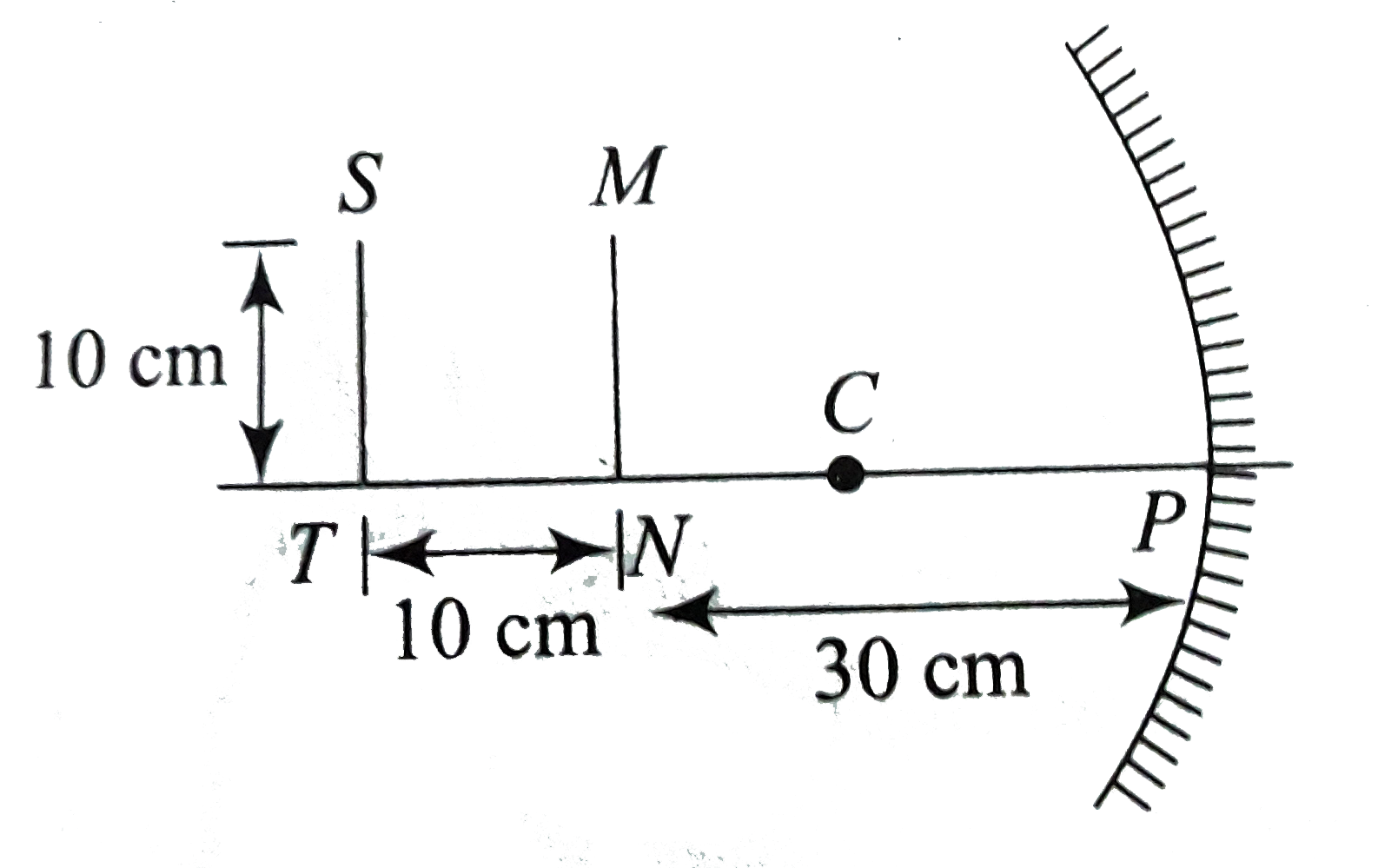 03:11View Solution
03:11View SolutionAn object ABED is placed in front of a concave mirror beyond the center of curvature C as shown in figure., State the shape of the image.
 01:23View Solution
01:23View SolutionA gun of mass M fires a bullet of mass m with a horizontal speed V. The gun is fitted with a concave mirror of focal length f facing towards the receding bullet. Find the speed of separation of the bullet and the image just after the gun was fired.
10:53View SolutionThe distance between two point sources of light is `24cm.` Find out where would you place a converging lens of focal length `9cm,` so that the images of both the sources are formed at the same point.
03:55View SolutionTwo thin sysmmetrical lenses of different nature and of different material have equal raii of curvature `R=15cm`. The lenses are put close together and immersed in water `(mu_(w)=4//3)` . The focal length of the system ini water is 30cm. The difference between refractive indices of tthe two lenses is
02:31View SolutionA glass sphere of radius `R=10cm` is kept inside water. A point object O is placed at `20cm` from A as shown in figure. Find the position and nature of the image when seen from other side of the sphere. Also draw the ray diagram. Given, `mu_g=3//2` and `mu_w=4//3`
 09:21View Solution
09:21View SolutionA spherical convex surface separates object and image spaces of refractive indices 1.0 and `4//3` . If radius of curvature of the surface is 10cm, find its power.
01:22View SolutionA tranparent sphere of radius 20cm and refractive index 1.6 is fixed in a hole of the partition separating the two media: A(refractive index ` n_(1)=1.2)` and B ( refractive index `n_(3)=1.7)`. A luminous point object is placed 120cm from the surface of the sphere iin medium A. it is viewed from D in medium B in a direction normal to the sphere. Find the position of the image formed by the rays, from point N.
 02:04View Solution
02:04View SolutionA cubical block of glass, refractive index 1.5, has a spherical cavity of radius `r=9cm` inside it as shown in figure . A luminous point object O is at a distance of 18cm from the cube. What is the apparent position of O as seen from A?
 02:55View Solution
02:55View SolutionA glass sphere, refractive index 1.5 and radius 10cm, has a spherical cavity of radius 5cm concentric with it. A narrow beam of parallel light is directed into the sphere. Find the final image and its nature.
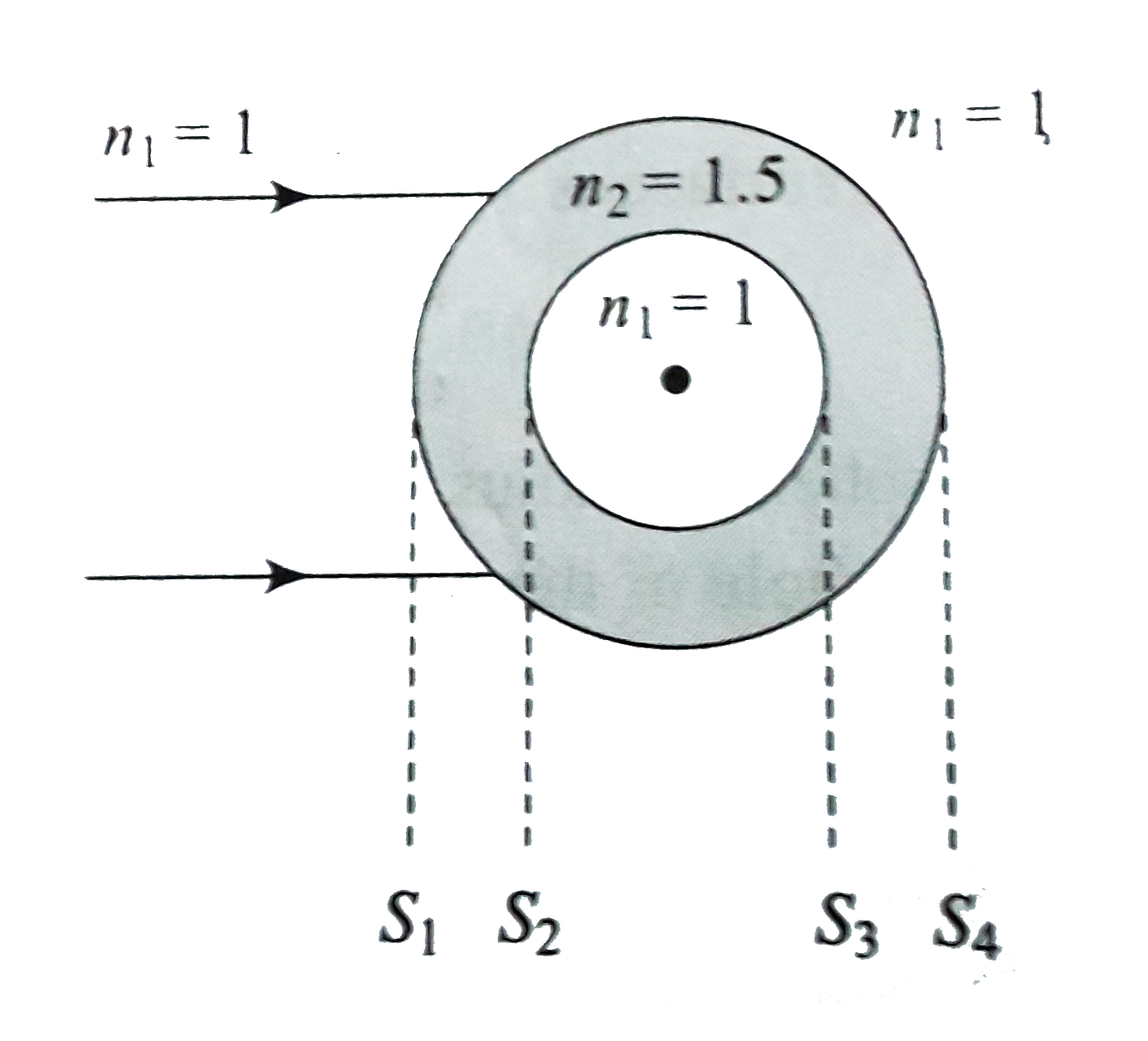 03:01View Solution
03:01View SolutionA luminous object and a screen are at a fixed distance D apart. A converging lens of focal length f is placed between the object and screen. A real image of the object in formed on the screen for two lens positins if they are separated by a distance d equal to
01:21View SolutionFor the same statement as above, the ration of the two image sizes for these two positions of the lens is
02:36View SolutionFor statement of question 118, if the heights of the two images are `h_(1)` and `h_(2)` , respectively,then the height of the object (h) is
01:03View SolutionThe focal length of the lens used in question 118 is
01:05View SolutionIn question 118, if `m_(1)` and `m_(2)` are the magnifications for two positions of the lens, then
02:20View Solution
Single Correct questions and complete solutions for chapter GEOMETRICAL OPTICS of CENGAGE PHYSICS (HINGLISH) of Class 12
